
Simple Wound Care Page Menu: 1 2 3 4 5 6 Next>>
Simple Wound Care in the Golden Age of Piracy, Page 5
Step 5 of Simple Broken Skin Wound Care: Remedy Complications
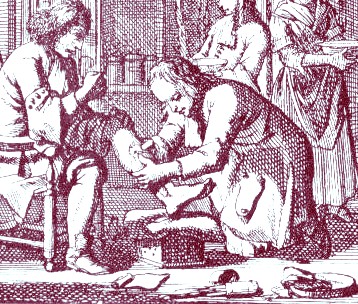
Artist: Jan Luyken - Examining a Wound, From Het Menesylk (1694)
When a wound didn't heal correctly, complications arose which had to be dealt with by the surgeon. A wide variety of complications are mentioned by period authors. As Ambroise Paré dryly notes, "the correction of those Symptomes or Accidents which are accustomed to follow Wounds, which thing verily makes the Chirurgeon have much to do."1
Sea surgeon John Woodall explained that the "generall accidents most to be feared that affect the wounded are Hemoragia [bleeding], dolor [pain], tumor, intemperature, a fever, faintnes of the heart [and] convulsions"2. Ambroise Paré also supplied a list of a variety of complications including "bleeeding [sic], pain, inflammation, a fever, convulsion, palsie, talking idly, or distraction, and the like."3
Since Woodall's complication 'intemperature' was already discussed in Step 4 under Indirect Humor Treatments, the reader is directed there for more information. Let's look at the rest of these complications through the eyes of our period surgeons.
1 Ambroise Paré, The Workes of that Famous Chirurgion Ambrose Parey, 1649, p. 255; 2 John Woodall, the surgions mate, 1617, p. 129; 3 Paré, p. 255
Remedying Complications - Hemorrhage
Bleeding has already been discussed a couple times in relation to wounds. However, bleeding which occurred after the wound had been treated is considered a
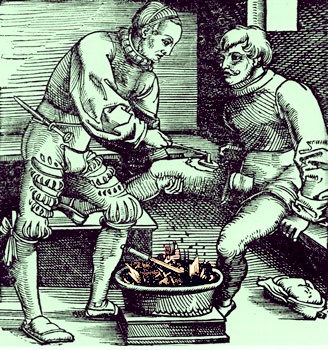
Cauterizing a Leg Wound, From Chirurgicorum Omnium
Primarii, by Albucasis (1532)
occasional complication of wound healing rather than a normal part of it. Woodall advises that such hemorrhages are to be "stayed by medicaments
astringent, fitted and applied with convenient suture or ligature [bandage] and sometimes by medicines causticke, either actual or potential."1 Suturing and bandaging were covered previously and Woodall does not list any particular astringent medicines here. However, Woodall's comment about using cauteries is of interest.
Cauterizing basically involved burning the wound shut to stop the bleeding. Potential cauteries were medicines used to achieve this end. Some examples include arsenic, caustic 'stones', nitric acid, lixivium and vitriol. Actual cauteries were formed steel tools heated red hot and applied to the bleeding area. A wide variety of tools were made to stop bleeding in different shapes of wounds. it should be noted that although Woodall recommended this process, cauterizing to stop bleeding had been losing favor before the golden age of piracy. While some traditional surgeons still relied upon it (particularly in stubborn cases such as this), other methods were generally preferred.
Paré recommends "Medicines which have an astringent, cooling, drying, and glutinous [adhesive] faculty"2. Being a fan of compounded medicines, he prescribes a couple of them. The first contains sealed and Armenian earths, Frankincense, Mastic, Myrrh, Aloes, Mill Dust combined with egg white. The second is much simpler, using only Frankincense and Aloes mixed with egg white and rabbit's fur.3 (You may recall that this is the same concoction suggested by Richard Wiseman, likely taken from Paré's book.4)
1 John Woodall, the surgions mate, 1617, p. 129; 2,3 Ambroise Paré, The Workes of that Famous Chirurgion Ambrose Parey, 1649, p. 255; 4 Richard Wiseman, Severall Chirurgicall Treatises, 1676, p. 351-2
Remedying Complications - Pain
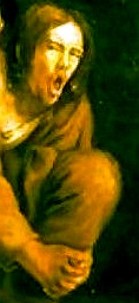
Artist: Gerrit Lundens (1649)
Relieving the patient's pain was an important part of preventing complications, as some of the other complications will attest. Richard Wiseman advised, "that nothing dispiriteth your Patient more, nor maketh more disturbance in Wounds, the Humours flowing abundantly to the pained Part, whence insueth great Inflammation and Tumour."1 Ambroise Paré ordered that "pains which follow upon wounds ought to be quickly asswaged, because
nothing so quickly dejects the powers, and it alwayes causes a defluxion [at the wound site]... for Nature ready to yeeld assistance to the wounded part, alwayes sends more humors to it, than are needfull for the nourishment thereof"2.
When there is an unwanted flow of humors, a humor-altering response is usually recommended. Wiseman recommends bleeding as an antidote to pain, "for that it maketh evacuation and derivation [diversion from the wound site] of the serous Humour which caused the grievance."3
However, medicines seem to be Wiseman's preferred response to pain. He ordered the surgeon to "hasten to succour it [the wound site] by Anodynes [pain-relieving medicines]"4. He suggests a number of medicines for relieving pain, beginning with ingredients used to bathe the part and make poultices to put on the wound. These include marsh mallow root and plants, henbane, mullain, barbed scullcap,

Scutellaria barbata (Barbed Skullcap)
rose petals, chamomile flowers, melilot flowers, flax seeds, fenugreek seeds, quince seeds and white opium. Such ingredients are to be "boiled in the Broth of a Sheep's head and feet, or new Milk."5 He also recommends a cataplasm when the pain first starts made of bean and barley meal, red rose petals and elder flowers heated in red wine or oxycrate (vinegar and water) and mixed with oil of roses.6
Paré relies on medicines as well, explaining that since pain is "the author of defluxion [flows of unwanted humors], let such medicines be applyed to the part as have a repelling and mitigating [alleviating] faculty"7. His prescribes two types of emplasters, plaster of Diachalciteos and another made from oil of myrtles, oil of roses, white beeswax, and barley meal combined with sealed and Armenian earths. Paré also suggests simply washing the wound with oil of roses and oil of myrtles mixed with an egg. He further notes that wound bandages are to be soaked in oxycrate (vinegar and water) to help alleviate pain. If all these medicines fail to work, Paré recommends narcotics such as oil of poppies or mandrake and a cataplasm made from henbane, sorrel and marsh mallows.8
1 Richard Wiseman, Severall Chirurgicall Treatises, 1676, p. 352; 2 Ambroise Paré, The Workes of that Famous Chirurgion Ambrose Parey, 1649, p. 257; 3,4,5,6 Wiseman, p. 352; 7,8 Paré, p. 257
Remedying Complications - Inflammation and Tumors (Apostemes)
To understand the treatment of inflammation during the golden age of piracy, you have to understand what was believed to be its cause. Not surprisingly, corruption of humors at the wound site was said to be at the heart of the problem. Richard Wiseman explains that "Pain stirs up a Heat fermenting in the serous part of the Blood [one of the four bodily humors], which readily makes way to the Wound, and, if not timely prevented, distendeth and raiseth the Part into a Tumour with Inflammation."1 He goes on to say that "if the Wound be in a declining Part, as the Legs, the influx of Humours is more abundant; and the Member through its weakness not being able to assimilate, nor yet expel them, is the cause that Crudities do heap upon the lower Parts, and make an Oedamatous Tumour."2
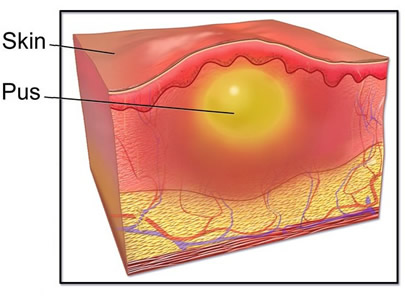
Artist: Blausen.com staff - Abscess/Aposteme Diagram, Blausen Gallery
Tumors as a result of inflammation require further explanation. Sea surgeon John Woodall includes tumors among his list of complications for wounds stating that, "A Tumor is an unnaturall increase exceeding the naturall state in the body, and inducing an offence of the actions of the same".3 Just as Wiseman's qualifies the type of tumor occurring in wound as 'Oedamatous', Woodall is talking about an aposteme (which he elsewhere notes is actually a type of tumor4) - one that is like an edema (thus the use of the adjective 'odematous') which is a swelling under the skin containing serum and pus.
Woodall says that some surgeons open apostemes using incision knives (scalpels), a practice of which he disapproves. He explains that "it is a grosse error in the Surgion, and painfull to the Patient ordinarily as some doe to open Tumors by incision" since the incision will either heal and have to be opened again or be held open by tents (folded pieces of cloth) or sponges.5 Woodall instead advises that "causticke medicine saveth all that labor, with great honour to the Artist [surgeon], and no small profit and convenience to the diseased."6 Caustics would burn the aposteme open and heal more slowly, presumably allowing the matter inside the tumor to drain so that it could heal.
Since he considers pain to be the source of the problem, Wiseman says that when 'great Inflammation and Tumour' occur, you have to use anodyne [pain relieving] medicines.7 His recommended medicines for treating pain were detailed in the previous section.
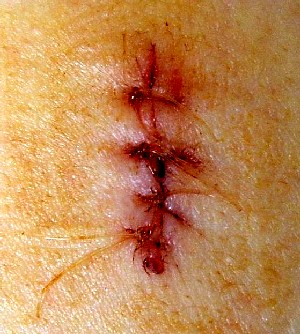
Photo: Carsten Niehuas - Infected Sutured Wound
In addition to anodynes, Wiseman also presents a surgical strategy for treating an infection in a case study concerning a sailor wounded by "thrust with a Rapier into the outside of his Arm nigh the Biceps."8 The wound became infected under the treatment of another surgeon who had stitched it closed, so the patient was brought to Wiseman.
The Arm being swelled and inflamed, I cut the Stitches open, and gave vent to a bloudy Sanies [serum, blood or pus], after which followed a digested [broken down] Matter. Finding by search with my Probe the Wound wanted little of passing through, I embrocated [bathed] & drest it up with Bandage to cure it. But it not yielding thereto, I passed a Seton-needle through, discharging the Matter downward; and after that Apertion [opening] was digested, I dilated it, and kept a Tent [folded piece of lint or other fabric] there a few days; during which the upper part of the Wound healed up: and the Wound below digesting well, and the Matter daily lessening, I also healed that up.9
Wiseman finishes this description by explaining that "such Wounds ought not to be stitcht, but drest up with Astringents, Compress and Bandage", adding that tents should only be used when needed because they extend the amount of time the infected wound takes to cure.10
1,2 Richard Wiseman, Severall Chirurgicall Treatises, 1676, p. 347; 3 John Woodall, the surgions mate, 1617, p. 129; 4 Woodall, p. 147; 5 Woodall, p. 1; 6 Woodall, p. 1-2; 7 Wiseman, p. 352; 8,9,10 Wiseman, p. 364
Remedying Complications - Fever
Both Ambroise Paré and sea surgeon John Woodall list fevers as a complication that can accompany wounds. Richard Wiseman states, "Fever accompanies great [large] Wounds; especially where there is Inflammation, it is almost inseparable; therefore you are the less to trouble yourself thereat."1 From this statement, Wiseman appears to view fever as a natural part of the healing process. However he goes on to say that if a fever remains after the inflammation of the wound and pain are cured, "there is great cause to doubt the welfare of your Patient"2.
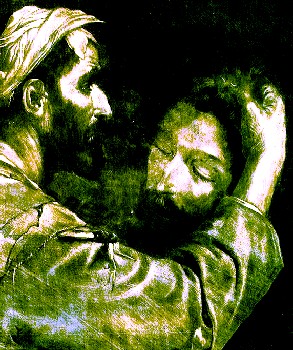
Artist: Prince Rupert of the Rhine (1658)
Wiseman recommends a variety of humor-based treatments to cure these types of fevers including 'loosening' the body using enemas and gentle emetic medicines, as well as blistering and bleeding designed to "hasten Revulsion"3. Revulsion is the notion that corrupt humors can be drawn away from a wound site by humor-based treatments such as bleeding and blistering a part of the body distant from the wound.
Woodall employs similar methods to treat fevers accompanying wounds. He explains, "Fever is a heate in the heart more then naturall, infused and dispersed through the whole body, whose cure is by purging [via enemas and emetics], bleeding, and good government."4 'Good government' is a call back to maintaining the wound temperament through the creation of a conducive environment in the body as discussed in Step 4.
Wiseman also recommends medications in a fever, something Woodall does not mention. He says the surgeon should "prescribe Juleps [sweet, flavored, distilled drinks], Emulsions [oily medicines mixed into regular liquids], Epithems [topical medicines, apparently applied to the wound], which, by refrigerating [cooling] and contemperating [tempering] the heat, may relieve the Patient."5 He does not list any specific medicines, leaving their choice to the reader.
While Paré identified fevers as a unique complication in his list, he does not address their cure directly, instead tying it into his discussion of of another complication - convulsions. He explains that "it is better a Feaver follow a Convulsion, than a Convulsion a Feaver... for the abundant and gross humor causing the Convulsion is digested [broken up] and wasted by the feaverish heat."6 He doesn't provide details on how to treat a fever accompanying a wound, apparently viewing them as a natural part of the healing process.
Sea surgeon John Atkins doesn't have a lot to say about complications, although he does suggest that when a fever accompanies a healing wound, "there is no better Medicine than the Bark [guaiacum] {2 scruples} in a Bolus [medicinal dose taken via the mouth] with Syr e Mecon. and repeated every 4 or 6 Hours."7
1,2,3 Richard Wiseman, Severall Chirurgicall Treatises, 1676, p. 352; 4 John Woodall, the surgions mate, 1617, p. 129; 5 Wiseman, p. 352; 6 Ambroise Paré, The Workes of that Famous Chirurgion Ambrose Parey, 1649, p. 258; 7 John Atkins, The Navy Surgeon, 1742, p. 170
Remedying Complications - Convulsions
Like fevers, both Ambroise Paré and sea surgeon John Woodall mention convulsions - involuntary contractions - in their list of wound complications. Both explain that convulsions can be caused by Repletion (an excess of fluid at the wounds site) or Inanition (a wasting away of the

Patient Convulsing, From Physiognomy, by Charles Bell
From the Wellcome Collection (1824)
part caused by a lack of nourishment).1 Paré adds that they can also be caused by "Sympathy or consent of pain"2. He has to most to say about the cause and treatment of convulsions accompanying wounds.
Where there is repletion at the wound site, Paré says the humors 'abound' which can be caused by "dulling the body by immoderate eating and drinking, and omission of excercise or [omission of] any accustomed evacuation". As a result "excrementitious [foul] humors [are] drawn into the Nerves, with which they being replete and filled, are dilated more than is fit, whence necessarily becoming more short, they suffer Convulsion."3 The cure for this is "discussing [breaking down] and evacuating [via emetic, diuretic and laxative medicines]: as by diet conveniently appointed by purging, bleeding, digestive locall Medicines, exercise, frictions [rubbing], sulphurious baths and other things"4. He later adds "slender diet, and sweating with the Decoctions of Guiacum because by these remedies the gross, tough, and viscid excrements, which are in fault, are digested."5 This is quite and impressive list; there are few treatments I have come across that employ more humoral remedies than this one.
Inanition is the opposite problem - a lack of humors flowing to the wounded part. Paré explains, "Immoderate vomitings [via emetic medicines], fluxes [via diuretic and laxative medicines], bleedings, cause Inanition or Emptiness, wherefore a Convulsion caused by a wound, is deadly"6. As a result, the "humidity of the Nerves is wasted, so that they are contracted like leather which is shrunk up, by being held too neer the fire"7. Repletion
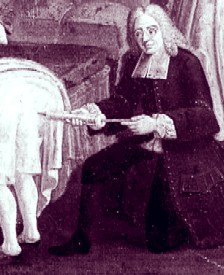
Administering a Clyster (1700)
is to be cured by the use of those things, which do wholesomly and moderately nourish. And therefore you must prescribe a diet consisting of meats full of a good nourishment, as broaths and cullices [broths] of Capons, Pigeons, Veal, & Mutton, boyling therein Violet and Mallow leaves. Conserves [preserves] must be ordained, which may strengthen the debilitated powers, and humect [moisten] the habit of the body, such as are, the Conserves of Bugloss, Violets, Borage and water Lillies. ...Clysters [enemas] shall be appointed, made of the decoction of a sheeps head and feet, Mallows, Marsh Mallows, Pellitory of the wall, Violet leaves, and other things of the like faculty; or that the remedy may be more ready and quickly made: let the Clysters be of Oyl and Milk. Topick remedies shall be Linimentii [liniments] and Baths. ...Make a Bath into which let the Patient enter when it is warm. When he shall come forth of the Bath, let him be dried with warm clothes, or rest in his bed avoiding sweat. But if the patient be able to undergo the charge, it will be good to ordain a bath of milk, or oyl alone, or of them equally mixt together.8
Paré says that convulsions caused by pain are due to damage to the nerves "whereby it comes to pass, that by causing great and bitter pain in the nerves they are contracted towards their originall, that is, the Brain... By which it appears that not only the brain it self suffereth together with the Nerves, but also the Nerves with the Brain."9
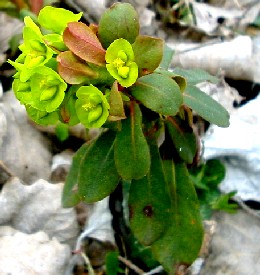
Euphorbia Wood Spurge
He advises the cure be made by remedies that are opposite to the cause of the pain. For 'pricked Nerves or tendons' he advises "oyl of Turpentine, of Euphorbium, mixt with Aqua vitae,and also with other remedies appropriated to punctures of the nerves."10
Although both Wiseman and Woodall talk about convulsions, they have nowhere near as much to say about them. Woodall explains that convulsions are "a dangerous disease of the braine, which often-times is a fore-runner or a rnessenger of death."11 As for a remedy, he simply says that "for the most part [they are] very dangerous, and of difficult cure."12
Wiseman explains that convulsions "ariseth from putrid Vapours, or acrid Matter offending the Nerves, which is often found in these Wounds."13 He also points to the brain as the source of the problem, apparently being affected by the poisonous humors the wound is producing. Wiseman doesn't really suggest any treatment for convulsions, admitting "The Prognostick here is always fatal, a Convulsion upon a Wound being the forerunner of death."14 He goes on to describe his attempt to cure a man whose arm was 'shot off near the Shoulder' with various anodyne medicines and by blistering the patient's legs to attempt drawing the humors away through revulsion, but he admits at the end "it was too late, he died howling."15
1 Richard Wiseman, Severall Chirurgicall Treatises, 1676, p. 437 & Ambroise Paré, The Workes of that Famous Chirurgion Ambrose Parey, 1649, p. 257; 2 Paré, p. 257; 3,4,5,6,7 Paré, p. 258; 8 Paré, p. 258-9; 9,10 Paré, p. 258; 11,12 John Woodall, the surgions mate, 1617, p. 130; 13,14,15 Wiseman, p. 437
Remedying Complications - Palsy
Only Ambroise Paré specifically includes palsy among his wound complications. He explains that palsy "is the resolving [reduction] or mollification [softening] of the nerves, with privation of sense and motion, not truly of the whole body, but of the one part thereof, as of the right or left side."1 He says the cause of palsy as a complication of a wound can be internal, such as "humors obstructing one of the ventricles of the brain, or one side of the spinall marrow", or external, including "a fall, blow, and the like injuries,
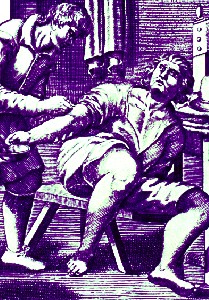
From Nuova et Utlilssima Prattica
di Tutto, By Cintio d'Amato (1671)
by which oft-times the joints are dislocated, the spinall marrow wrested aside, and constrictions and compressions of the Vertebræ arise". These things keep the 'animal spirits' from reaching the member.2
Richard Wiseman lumps symptoms of palsy associated with wounds in with contractions, explaining that when the damage is near the knee or shoulder "Contraction cannot be discerned but by a Trembling, which Trembling is usually attended by a Convulsion of the Joints."3 This he says is fatal. However, similar to Paré, Wiseman also talks about paralysis in "some Part or Parts, and [which] affects the Brain and Spinalis medulla [spinal cord]. But in Palsies which arise from Wounds the Parts immediately affected are the Nerves of that place only."4 This he notes is not fatal, "though it may sometimes threaten a Mortification [gangrene] through defect of natural heat in the Member."5
While sea surgeon John Woodall doesn't specifically mention palsy as a possible complication of wound cure, he does discuss paralysis (one of the symptoms of palsy associated with wounds) and explains that it is one of "divers other like accidents"5. He places the blame for such problems in a wounded member on a defect in the brain, noting that such problems were challenging for the surgeon to heal.
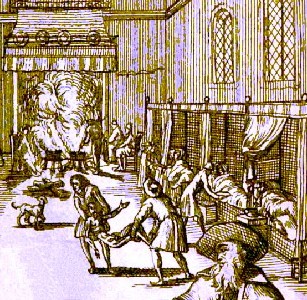
Sweating Patients, From De Spaanse pok-meeste,
By David Abercromby (1691)
As befits a problem that he blames on humors, Paré's first recommendation for curing palsies accompanying wounds is to try "generall remedies, diet, and purging". He specifically advises the use of guaiacum as being "very fit for this purpose, for it procures sweat and attenuates, digests, and drieth up all the humidity which relaxeth the nerves"6. If that fails to produce sweating, he suggests a variety of other methods which can be found in the discussion on the practice of using sweating to eject unwanted humors from the body. He also recommends that liniments be applyed to "the spine of the back, and parlalytick limb"7. Once these procedures are used, the surgeon must "appoint exercises of the affected parts, and frequent and hard frictions [rubbing],
with hot linnen clothes, that the native heat [of the part] may be recalled and the excrements [corrupted humors] contained in the parts digested: you may also use the Chymicall oyls of Rosemary, Tyme, Lavander,
Cloves, Nutmegs and lastly, of all spices"8.
Wiseman employs a slightly different method in one of his case studies, first bringing the wound to suppuration (with the pus coming out of the wound believed to be the corrupt humors) and using a restrictive medicine to stop the wound from bleeding. He then used several other humor-based curative procedures including bleeding and purging. Finally, he bathed the hand using a distilled oils of earthworms, germander, dill, lillies along with the compound medicine unguentum nervinum.9
1 Ambroise Paré, The Workes of that Famous Chirurgion Ambrose Parey, 1649, p. 259; 2,3 Richard Wiseman, Severall Chirurgicall Treatises, 1676, p. 437; 5 John Woodall, the surgions mate, 1617, p. 130; 6,7 Paré, p. 260; 8 Paré, p. 261; 9 Wiseman, p. 437
Remedying Complications - Other Neurological Problems
There are several other neurological issues accompanying wounds discussed in the period surgical books. In their initial lists, sea surgeon John Woodall mentions "faintnes of the heart"1 and Ambroise Paré includes "talking idly, or distraction, and the like."2 Unlike the other neurological complications already discussed, these are all lumped together with other neurological problems.
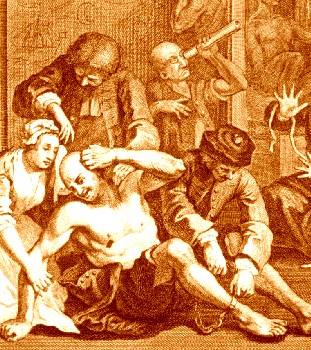
Artist: William Hogarth
In the Madhouse, The Rake's Progress 8 (1763)
Woodall mentions several additional symptoms of what he calls 'diseases of the braine' which occur when "the substance of the braine be offended, the functions thereof are impedited [impeded],
whence proceedeth doting, melancholy, foolishnes, slothfulnesse, Lithargy [lethargy], frenzy, madnes, losse of memory, deadish sleepe, giddinesse, apoplexie [unconsciousness caused by hemorrhage], Paralisis,and divers other like accidents formerly recited."3 You will note that paralysis is included in his list, although it was discussed in the previous section on palsy since it seemed relevant there.
Paré mentions a variety of symptoms as well including raving, talking idly and doting (notably leaving out distraction which he earlier mentioned). He explains that these things "commonly happeneth in feavers caused by a Wound, and inflammation; and it is a perturbation of the phantasie, and function of the mind, not long induring."4 Although it sounds as if he is dismissing the importance of such symptoms, Paré goes on to mention a wide variety of other possible reasons for such behaviors including "vehement pain, and a feaver", "too much bleeding", the bite "of a venemous beast, a seed retained or corrupted in the womb, or from a Gangrene of Sphacel [sphacelation or mortification], from a venenate [poisonous] and putrid air carried up to the brain, or from a sodain tumult& fear" as well as a hot distemper.5 He sums all these various causes up as being "the afflux [flow] of humors, specially cholerick [the humor black bile], by disipation, oppression or corruption of the spirits."6
Paré's solution to such neurological complications is
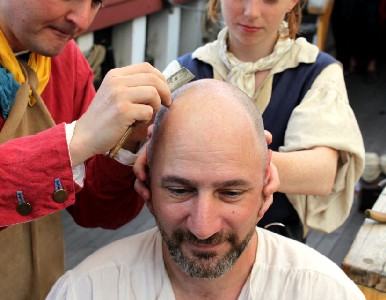
Photo: The Author's Camera - The Surgeon Shaving A man's Head
after purging and blood-letting by the prescription of a Physitian, the hair being shaved or cut off, the head shall be fomented with rose vinegar, and then an Emplaister of Diacalcitheos dissolved in oyl and vinegar of Roses, shall be laid thereupon. Sleep shall be procured with Barly creams wherein the seeds of white Poppy have been boiled, with broths made of the decoction of the cold seeds of Lettuce, Purslain, Sorrell, and such like. Cold things shall be applyed to his nostrills, as the seeds of Poppy gently beaten with Rose water and a little vinegar. Let him have merry and pleasant companions that may divert his mind from all cogitation of sorrowful things, and may ease and free him of cares, and with their sweet intreaties may bring him to himself again.7
John Woodall's remedy to such problems is entirely medicinal. He advises the reader use drying medicines including "Spirtus vini [brandy], bolus Arminiæ [Armenian earth], Terra sigillata [sealed earth], Litharigirum [lead oxide], Cerusa [white lead]; Tutia [zinc oxide], adust [burnt] lead, burnt paper, Allom [alum] water, burnt Vitriole, Ung: de siccans rub [red drying unguent]; Diapompholigos, & Diapalma"8. Woodall finishes his discussion of treating neurological problems by noting that since "the accidents of the wounded are divers [many], so the remedies are not all alike: but some are generall, others more peculiar."9
1 Ambroise Paré, The Workes of that Famous Chirurgion Ambrose Parey, 1649, p. 255; 2 John Woodall, the surgions mate, 1617, p. 129; 3 Woodall, p. 130; 4,5 Paré, p. 261; 6 Paré, p. 261-2; 7 Paré, p. 262; 8,9 Woodall, p. 130

